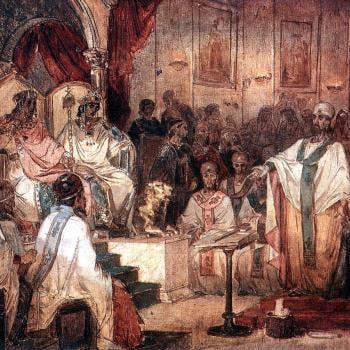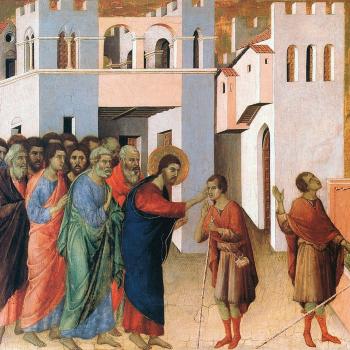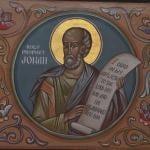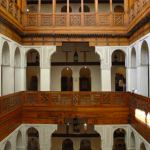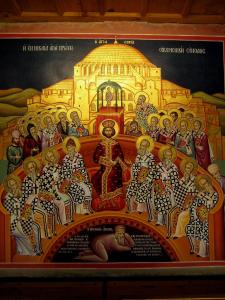
“And this is eternal life, that they know thee the only true God, and Jesus Christ whom thou hast sent” (Jn. 17:3 RSV). The Christian faith is about a personal, experiential relationship with Jesus, a relationship which allows them to join themselves to him and participate in the glory of the divine life through him. We know the one who has been sent into the world, the divine person who became incarnate so as to reveal to us the fullness of divine revelation in a form which we can properly apprehend, but also in a form which is able to personally interact with us and transform us through our interaction. We come to know him and his relationship with his Father, and through it, we receive also the gift of the Spirit. We discover that the Father, Son and Spirit are one, and yet there remains personal distinctions between them. We learn that there is no simple monism in the Godhead, and that because we and the whole of creation is created in the image and likeness of God, we are also meant to be one in a way which still allows for plurality (or diversity). We can come to know and understand these truths in a variety of ways, some which can be put to words, but many in ways which cannot.
We might want to be silent. We might just want to rest in our transcendent experience of Jesus, in the truth which lies beyond words. But we cannot. “Who do you say I am”? That is the question Jesus asked Peter, and it is a question which Christians, over time, have found themselves coming to time and time again. It is certainly the question that raised itself even more after Jesus’ death and resurrection from the dead. It is the main question which lay behind the Council of Nicea. It is not because Christians did not, in general, have a sense of who they believed Jesus to be; rather, they did not know how to put their faith into words. Many different traditions developed, many different ways to express the truth, emerged. The problem is that many come to understand those traditions in a simplistic, fundamentalistic way, and started to use them and reify them in ways which ended up contradicting the intention and meaning behind them. Christians began disputing with each other as to who Jesus is, with some, taking the literalistic interpretation of the words they learned to describe him against those who used other formulas, until some understood one such formula, taken in part from Scripture, as saying he was the first-born of creation, the greatest creature ever made by God. This interpretation is what the Arians following Arius stated. Christian intuition, the faith which preceded this systematic interpretation of Christ, said otherwise—Jesus was and is God, God with us, God who became one with us, and not just another creature. It was not easy to express how this could be, and it would take centuries before Christians would have developed the technical vocabulary they needed to explain how this was possible, with Nicea serving as the foundational turning point with the way it used the word homoousios (of the same substance or essence) to explain the way the Father and the Son (and the Holy Spirit) were one even if they were distinct.
Thus, we find at the time of Nicea, Christians had been given back their freedom in society, their freedom to worship, and with it, they received back many of the lands which had been unjustly taken from before Constantine came into power. Now that they were free and did not have to worry about secular society, they got to look inward and see that the Christian message, over time, had become confused, and that there was the need to end that confusion, to make sure that Christians around the world had a general proclamation they can use to help counter that confusion. Constantine saw the need for this because, having come to believe in the Christian faith, and the way he believed it could and would find its place in Rome, he saw the infighting of Christians interfering not only with the Christian witness but also with society as a whole. Christians threatened the unity and peace he wanted to establish. To solve the problem he saw brewing, he had Ossius of Cordova first investigate what was happening in Alexandria surrounding the conflict between the Patriarch Alexander of Alexandria and Arius, and later, to convene the Nicene Council in order to have Christians come together and affirm together what it is they believed about Jesus (that Jesus is the Christ, the Son of the Living God, the Son of the Father, eternally begotten of the Father before all ages, consubstantial or homoousios with the Father). However, it was not just the proclamation of the faith which was the concern of the council, it was Christian praxis, that is, there was the need to have some basic principles or disciplines expected to be followed around the world. The disciplines, to be sure, could be changed over time, and they were, but the principles behind them, just as the principles behind the Christological definition, remain.
The Nicene Creed itself was, at first, highly debated among Christians, even among those who agreed with its intended meaning because it introduced technical (philosophical) language into the official proclamation of the faith; that is, with the introduction of the word homoousios (consubstantial) into the creed, there were many who questioned what that would truly mean going forward, especially as the word could seem to imply the Father and the Son are one, not just in essence, but in person (as the word was previously used by modalists for that point). That is why we find a significant debate among those who agreed with the intention of the Nicene Creed as to the use of the homoousios, but the more they saw how it was employed to defend orthodoxy against Arianism, the more those who questioned its use began to accept it. Nonetheless, we find that what was begun at Nicea would need further exploration at later ecumenical councils, beginning with Constantinople, where the plurality in unity could be better explained by adapting another technical word to represent the plurality (hypostasis), which at the time of Nicea, was also used to represent the unity (at Nicea, it was understood as another term to use to describe the nature of God, while it would develop as a way to represent the persons of the Trinity).
Christians from the beginning have been challenged to find the right words to express their faith in Jesus. We still find it to be a challenge. We have been given contours to help us do so, contours which we should not neglect, as they will help us express our faith. But we should not see them as all that we can or should say. Jesus asked Peter who he said Jesus was, and Jesus asks us this as well. It is a question which we, likewise, should ask ourselves, as we look to and ponder Jesus and why we love him so much we identify ourselves with him and his mission to the world.
Stay in touch! Like A Little Bit of Nothing on Facebook.
If you liked what you read, please consider sharing it with your friends and family!
N.B.: While I read comments to moderate them, I rarely respond to them. If I don’t respond to your comment directly, don’t assume I am unthankful for it. I appreciate it. But I want readers to feel free to ask questions, and hopefully, dialogue with each other. I have shared what I wanted to say, though some responses will get a brief reply by me, or, if I find it interesting and something I can engage fully, as the foundation for another post. I have had many posts inspired or improved upon thanks to my readers.




